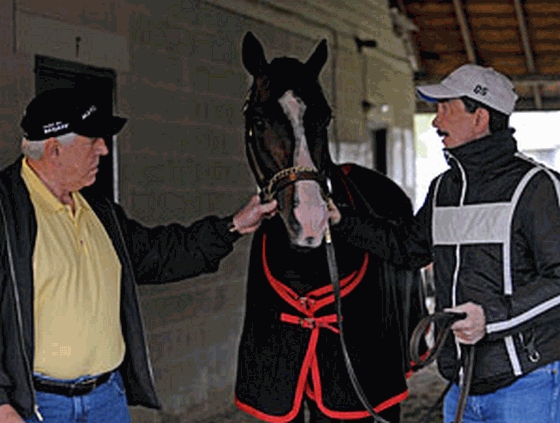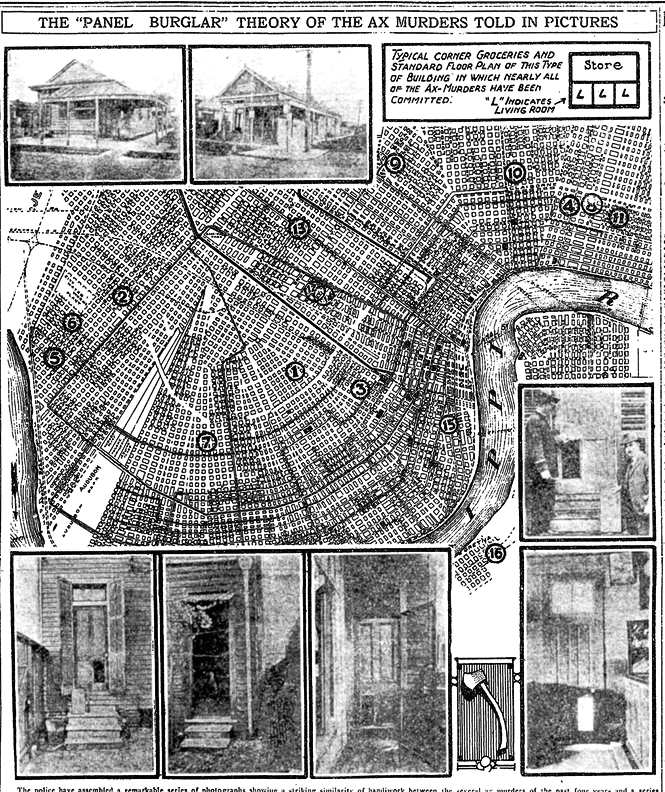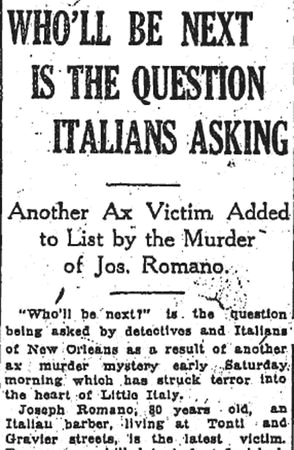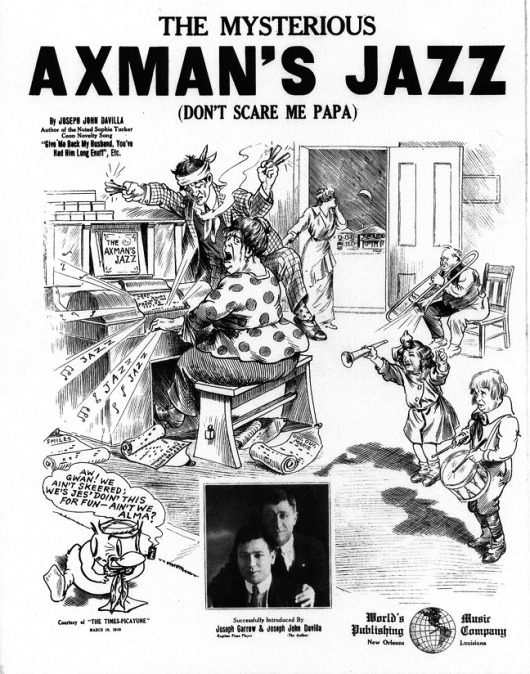|
Today in New Orleans History |
|
|
March 13


 Risen
Star was one of the most successful racehorses ever to come out of Louisiana. Sired by the legendary Secretariat, one of the
most celebrated racehorses in American history, Risen Star finished third in the 1988 Kentucky Derby and then won the other
two jewels in racing’s Triple Crown: the Preakness and the Belmont Stakes. Of the 699 offspring produced by Secretariat,
Risen Star would become one of the most successful of the famed 1973 Triple Crown winner’s progeny. However, like all
of Secretariat’s descendants, he would be subjected to unfair comparisons and unrealistic expectations. A leg injury
eventually forced him into a premature retirement. The stallion’s three-year-old season, in 1988, was truly stellar, with victories in the Louisiana Derby and the Lexington
Stakes, making him one of the favorites going into the Kentucky Derby. The “Run for the Roses” saw jockey Eddie
Delahoussaye boxed in down the back stretch, however, and despite a late charge, Risen Star finished third at Churchill Downs.
The dark bay turned heads two weeks later when he captured the Preakness, followed by a decisive 14¾-length victory
in the Belmont Stakes. In his trademark smooth and easy stride in the first half of the course, coupled with a dramatic
finish down the back stretch, Risen Star ran the fourth-fastest time in Belmont history, covering the mile-and-a-half course
in two minutes, 26.4 seconds, winning by fourteen lengths. Comparisons to his sire were inevitable, although Secretariat
covered the distance in two minutes, 24 seconds flat, thirty-one lengths ahead of the next-closest horse. Risen Star also
aggravated an injury to his right ankle during the Belmont that forced him into early retirement. The injury had been a source
of concern to Roussel all spring, but a severe strain to the suspensory ligament during the race hastened the decision. Risen Star won the 1988 Eclipse Award as American Champion Three-Year-Old Male Horse. He followed his sire Secretariat
in 1973 and his grandsire Bold Ruler in 1957 as a winner of the Eclipse Award, which honors American thoroughbred racing champions.
Risen Star won more than $2 million in purses during his short career, compiling a record of eight wins in his eleven races.
He also won $1 million as the horse with the best record in the 1988 Triple Crown races. Roussel donated ten percent of Risen
Star’s earnings to the Little Sisters of the Poor after having been cured of throat cancer. Risen Star was syndicated
for $7 million and stood at stud on Walmac Farms in Lexington, Kentucky. Two of his offspring, Star Standard and Risen Rave,
achieved modest success, although these horses were also subjected to the same unrealistic expectations that had been placed
on Risen Star as the son of Secretariat. In 1989 the Fair Grounds in New Orleans renamed the Louisiana Derby Trial Stakes
the Risen Star Stakes in his honor. It is run every February as one of the qualifying races for the Louisiana Derby. Risen
Star died on March 13, 1998, 10 years to the day after winning the Louisiana Derby. at Walmac Farms, where
he is buried. Written By S. Derby Gisclair. Photo of Risen Star, Ronnie Lamarque, and Louie Roussel III by Anne M. Eberhardt  

To receive an update for each day in New Orleans
history, join our facebook page
- Today in New Orleans History
Born on March 13, 1901 in Plaquemines Parish, Andrew Morgan played clarinet with the Imperial Band in the mid-1920s and then joined his brother Isaiah Morgan's band in 1925. Sam Morgan led this ensemble for its 1927 recordings. Andrew recorded in the late 1920s and 1930s with Kid Howard, Kid Rena, and Kid Thomas Valentine. He and Isaiah played together again in Biloxi, Mississippi in the 1940s, then Andrew moved back to New Orleans to play with Alphonse Picou, Kid Rena again, Herb Morand (1946–52), and Kid Clayton (from 1952). He played with the Young Tuxedo Brass Band from 1958 and led the group after 1964. Morgan played with Percy Humphrey in 1953, Sweet Emma Barrett in 1960, Kid Howard again in 1962, Alvin Alcorn in 1964, Onward Brass Band in 1965, Eureka Brass Band in 1969, and with Captain John Handy in 1970. He recorded as a leader in 1969 for the album Down By the Riverside. On March 13, 1892 the Daily
Picayune described City Park improvements since Anseman's appointment – including this drawing of the new “3000
foot fence and iron gate on Alexander Avenue painted red”. The article stated that CPIA had collected $1000 from the
city and $8000 in donations and membership fees and that it had cut weeds, placed circular benches around the dueling oaks,
built a Ladies Cottage rest-area (with parlors, closets and porches) near the gate, a Mens Cottage near Bayou Metairie, and
a footbridge across the bayou. It described “50,000 oranges, lemon and fruit trees for revenue” and a “palmetto
alley with Spanish dagger plants and lantanas”. And the Picayune described the Saux building -- “the
stuccoed hostelry of Jean-Mario [sic] on Alexander Street with its rose garden and green pea and thyme and orange trees where
in the past the order be given of pistols for two and coffee for one”. #042cp
Michel Doradou Bringier, planter, owner of Hermitage Plantation, Ascension Parish, La. Born,
December 6, 1789, allegedly at sea while parents were on a voyage; son of Marie Françoise Durand and Marius Pons
Bringier (q.v.). Education: Paris, France. Married Louise Elizabeth Aglaé Du Bourg, June 17, 1812,
in Baltimore, Md.; she was the daughter of Elizabeth Etiennette Bonne Charest and Pierre François Du Bourg, an adjutant
general on the staff of Gov. W. C. C. Claiborne (q.v.) at the Battle of New Orleans. Children: Marius St. Colombe
(b. 1814), Marie Elizabeth Rosella (b. 1818), Louise Françoise (b. 1820), Anne Guillelmine Nanine (b. 1823), Louis
Amédée (b. 1828), Marie Elizabeth Aglaé (b. 1830), Louise Marie Myrthé (b. 1834), Anne Octavie
Marie (b. 1839), and Martin Doradou (b. 1842). Given a plantation by his father as a wedding gift; first crops were
indigo and tobacco; later the vast acreage was converted to sugarcane cultivation; named his plantation mansion, which was
built between 1812 and 1814, the Hermitage, after the Tennessee home of Gen. Andrew Jackson (q.v.); bought Whitehall, the
family plantation, 1821; sold in 1825, it was repurchased by his widow in 1848. Died, March 13, 1847,
Memphis, Tenn.; interred family tomb, Catholic cemetery, Donaldsonville, La. Widow, Aglaé, died at Melpomène,
the family mansion in New Orleans, June 4, 1878. The Hermitage was bought in 1880 by Duncan F. Kenner (q.v.), husband
of Nanine Bringier. J.B.C. Sources: Herman de Bachelle Seebold, Old Plantation Homes and Family Trees, 2
vols. (1941); Jess DeHart, Plantations of Louisiana (1982); Marie Cruzat de Verges, comp., American Forces at Chalmette (1966).
From http://lahistory.org/site19.php Front page news in the Daily Picayune on September 28, 1911 announced the arrest of Miss Annie
Crawford, 28 year-old resident of 1011 Peters Avenue, for the poisoning of her 24 year-old sister Elise at their home. on
September 23. Elise had been ill for quite some time before her death. The Crawford family had lost
three family members within the past 15 months. On June 25, 1910, another sister, Mary Agnes Crawford died
suddenly -- the cause of death was attributed to Acute Meningitis. Three weeks later on July 15 her father,
Walter C. Crawford passed away -- the cause of death was allegedly Uremic
Poisoning. Two weeks after that, on July 29 her mother died -- it was thought that she also succumbed to Uremic
Poisoning. Upon the death of Elise suspitions were raised that the family might have
been victims of murder. Out of work since losing
her job, it was determined that she was the insurance beneficiary of each deceased family
member; Mary Agnes was insured for $300, her father for $800, her mother for $800, and
her sister Elise for $250. Another sister, Gertrude, said "I don't want Annie to nurse
me if I ever get sick. She gives such funny medicine". District Attorney St. Claire
Adams said, "It was established today the that Annie Crawford is a drug fiend and probably is addicted
to morphine. It is also established that she had access during the past three weeks to morphine and was
in a position to obtain it in practically any quantity. During the indisposition of Elise
Crawford she bitterly complained that her food and drink were drugged. I have charged Annie
Crawford with the murder of her sister Elise". The case came before the Grand Jury on October 10 and Annie
Crawford was indicted. On March 13, 1912 the trial began and she pled not guilty. She had admitted
to poisoning Elise with morphine capsules but said that she accidentally administered the wrong medication
-- she thought she had given Elise calomel tablets which she had purchased at Waldorf's Pharmacy. She
also admitted to being a morphine addict. Elise's body was, once again, exhumed for further examination. Laboratory
slides harvested from her organs were brought to the courtroom as evidence. Annie's attorney Lionel Adams exclaimed
that this was a "macabre display" while District Attorney St. Claire Adams objected. Tempers flared and the
two began to physically scuffle. While others in the courtroom attempted to quell the melee the slides were pushed and
went crashing to the floor. Annie was led from the room while fainting. During the trial, professors from Tulane
Medical School were called in as expert witnesses. Some opposed the opinions of others. Tulane students aligned
with the professor whose opinion favored Annie's innocence rushed to Parish Prison in an attempt to carry her away. Police
formed a ring of guards around the building and the students were barred from the courtroom. This spectacular trial,
which attracted national attention, ended as a mistrial on March 26, 1912 as a mistrial. The jury had voted 9-3 in favor
of an acquittal but were deadlocked and failed to reach a verdict. Anne Crawford was not tried for the murder
of her mother, father, or other sister because they had been buried too long for current
forensics to determine if they had been poisoned. On March 27, 1913, Elise's organs were released to Annie and
her remaining siste and reburied at St. Patrick's. The two sisters reported that they planned to move to Port Arhtur,
Texas. On June 10, 1912, Senator Schator Williams introduced a bill to prohibit written and oral confessions of prisoners.
Citing Annie Crawford's case as a "cruel example" of third degree methods used by Distrct Attorney Adams'
office as an example of coercive tactics, the bill passed with only one nay vote. A Wave of Terror Hell, March 13, 1919 Esteemed Mortal: They have never caught me and they never will. They have never seen me, for I am invisible, even as the ether
that surrounds your earth. I am not a human being, but a spirit and a demon from the hottest hell. I am what you Orleanians
and your foolish police call the Axman. When I see fit, I shall come and claim other
victims. I alone know whom they shall be. I shall leave no clue except my bloody axe, besmeared with blood and brains of
he whom I have sent below to keep me company. If you wish you may tell the police to be careful not to rile me. Of course, I am a reasonable spirit. I
take no offense at the way they have conducted their investigations in the past. In fact, they have been so utterly stupid
as to not only amuse me, but His Satanic Majesty, Francis Josef, etc. But tell them to beware. Let them not try to discover
what I am, for it were better that they were never born than to incur the wrath of the Axman. I don‘t think there
is any need of such a warning, for I feel sure the police will always dodge me, as they have in the past. They are wise
and know how to keep away from all harm. Undoubtedly, you Orleanians think of me as a most horrible murderer, which I am, but I could be much worse
if I wanted to. If I wished, I could pay a visit to your city every night. At will I could slay thousands of your best citizens,
for I am in close relationship with the Angel of Death. Now, to be exact, at 12:15 (earthly time) on next Tuesday night, I am going to pass over New Orleans. In
my infinite mercy, I am going to make a little proposition to you people. Here it is: I am very fond of jazz music, and I swear by all the devils in the nether
regions that every person shall be spared in whose home a jazz band is in full swing at the time I have just mentioned. If
everyone has a jazz band going, well, then, so much the better for you people. One thing is certain and that is that some
of your people who do not jazz it on Tuesday night (if there be any) will get the axe. Well, as I am cold and crave the warmth of my native Tartarus, and it is
about time I leave your earthly home, I will cease my discourse. Hoping that thou wilt publish this, that it may go well
with thee, I have been, am and will be the worst spirit that ever existed either in fact or realm of fancy. |
|
|

To receive an update for each day in New Orleans history,
join our facebook page - Today in New
Orleans History.
Analytics |
 Born on March 25, 1985, Risen Star was purchased by Louisiana-based owner Ronnie Lamarque and owner-trainer Louis Roussel
III in 1987. At two years old, Risen Star did not race much, but he did capture the Minstrel Stakes at Louisiana Downs.
Born on March 25, 1985, Risen Star was purchased by Louisiana-based owner Ronnie Lamarque and owner-trainer Louis Roussel
III in 1987. At two years old, Risen Star did not race much, but he did capture the Minstrel Stakes at Louisiana Downs.



